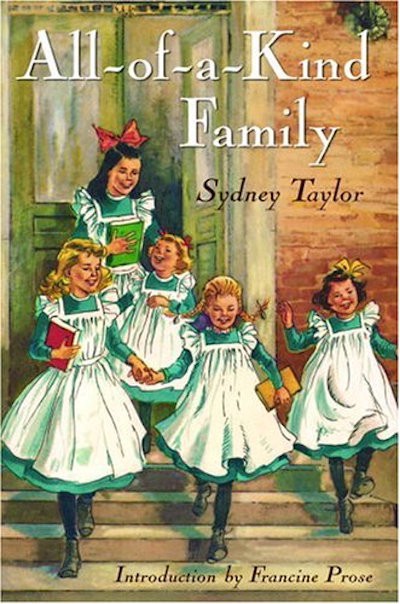What Children’s Literature Teaches Us About Money: Sydney Taylor’s ‘All-of-a-Kind Family’
When you try to save, but life gets in the way.

I grew up in a frugal family, where both my sister and I wore hand-me-downs (I was the oldest, so I wore hand-me-downs that had come from other families’ children, often my taller friends) and we spent a lot of time at the public library.
So even though Sydney Taylor’s All-of-a-Kind Family series is about a turn-of-the-century Jewish family living in a tenement on the Lower East Side, I felt an immediate kinship with the five sisters in Taylor’s story. (To the point that I have this vivid memory of telling my mom that today we were going to celebrate Purim, which in six-year-old Nicole’s interpretation meant bouncing on my knees in my dad’s brown La-Z-boy chair and shouting “Purim Day!”)

Unlike Little Women, where the characters announce their poverty in the second line of the book (and then we learn that they live in a big house with a cook and they’re probably closer to lower-middle-class than poor, and maybe we shouldn’t actually accept teenage Meg’s assessment of their income bracket as canon, but whatever) it takes an adult re-read to notice that the All-of-a-Kind Family is managing its finances very, very carefully.
The family—who never gets a surname—lives in “a four-room apartment which occupied an entire floor in a two-storied private house,” and Taylor correctly notes that this makes them privileged, compared to their peers. But the girls also own no books, which is why they spend so much time at the “heavenly” public library, and middle sister Sarah is saving up her pennies to buy a doll.
Unlike some stories, All-of-a-Kind Family doesn’t end with Sarah buying the doll, or with her parents gifting her the doll so she doesn’t have to buy it herself. Instead, we see Sarah put into multiple situations where she has to spend some of her saved-up pennies on something else: a missing library book, a birthday gift for their father, a treat for her sisters:
“Aren’t you going to spend your penny?” the children asked her. They couldn’t be sure because Sarah was saving all her pennies these days—six for the dolly and one penny for the library lady. But today was something special. She had shared in the goodies her sisters had bought. It would only be fair for her to return their generosity.
It’s one of those scenes that is a microcosm of adult life, or maybe one of those scenes that prepares you for adult life: the five girls are with their mother as she shops for food, and four of the girls spend pennies on treats for themselves, although they generously give tastes to their sisters (and you get the sense that sharing treats with four other people doesn’t leave a lot for yourself).
So now Sarah is stuck with this dilemma: does she return the favor, or does she save her money? She didn’t ask to share the treats, and it would have been rude for her to refuse, but now she’s obligated to spend her own money on something she wasn’t planning to buy.
This month SuChin Pak interviewed Neal Gabler (of the viral Atlantic essay The Secret Shame of Middle-Class Americans) about “the personal and systemic factors leading to his very current financial problem,” and Gabler said that one of the reasons he hadn’t been able to save as much as he wanted had been because “I was at the mercy of other people.”
Redefining Succes – presented by Umpqua Bank and SlateCustom
Which, I mean, how do we deal with this? We’ve written on The Billfold before about budgeting for friends and family or prioritizing the kind of treat-sharing that naturally happens in life, but that means setting aside less money for our doll or our savings or, in some cases, our day-to-day expenses.
That brings me to the other heartbreaking scene in All-of-a-Kind Family: the birthday present. The five girls agree to pool their money to buy a gift for their father, and they choose a cup and saucer with a moustache ledge built in, so the person drinking from the cup won’t get tea in their moustache.
Any other book would end the chapter either with this being a happily delivered present or with the father arriving home with a clean-shaven face (but he loves the gift anyway). This is how All-of-a-Kind Family does it:
Papa tugged at the cord, the wrapper fell away and the cup and saucer stood in splendor on the table. Papa stared at his present and said not a word.
The children were bewildered. What was wrong? What made Papa’s face look so sorrowful? Didn’t he like their present?
Papa was thinking: So much money spent on a fancy cup and saucer that I could just as well do without. Haven’t we enough cups and saucers in the house now? I have to work so hard to make enough for the necessary things and here they spend money on such a luxury. What if the amount they spent wouldn’t help much. It’s little spendings like this that add up.
It takes Papa a few more paragraphs to reconcile himself to this gift and accept his children’s generosity and love.
There are two more quick money scenes I want to reference: first, the chapter where Mama teaches the girls how to dust by asking them to find all of the buttons she’s placed around the furniture and shelves, and how every once in a while, one of those buttons is a penny. (Never underestimate the power of intermittent reinforcement.)
Second, the chapter where we learn how worried Mama is about wasting food, and how she’s created a system of rewards—and a poem—to ensure her daughters eat everything she serves:
No soup
No meat.
No meat
No vegetables.
No vegetables
No fruit.
No fruit
No penny.
She’s handing out what appears to be 35 pennies a week—the cost of Papa’s birthday cup and saucer—to prevent food waste, which makes me wonder what the household budget is, and how much their food costs, and whether it would be just as financially prudent to skip the pennies and let the girls eat what they wanted.
But Mama and Papa have agreed that their five daughters should have pocket money, and this is one way to make sure it is earned. Dolls don’t buy themselves, after all. Not even after you try and try to save.
(If we want to talk about the other books in the series, including the one where the girls dye a dress in tea to hide a stain, or the one where Henny tears up her stockings so she looks poorer than she is and crashes a Christmas charity drive so she can get a doll, I am ready to discuss those too. Let’s make it an All-of-a-Kind Family day at The Billfold.)
Previously:
What Children’s Literature Teaches Us About Money: Noel Streatfeild’s ‘Ballet Shoes’
Support The Billfold
The Billfold continues to exist thanks to support from our readers. Help us continue to do our work by making a monthly pledge on Patreon or a one-time-only contribution through PayPal.
Comments